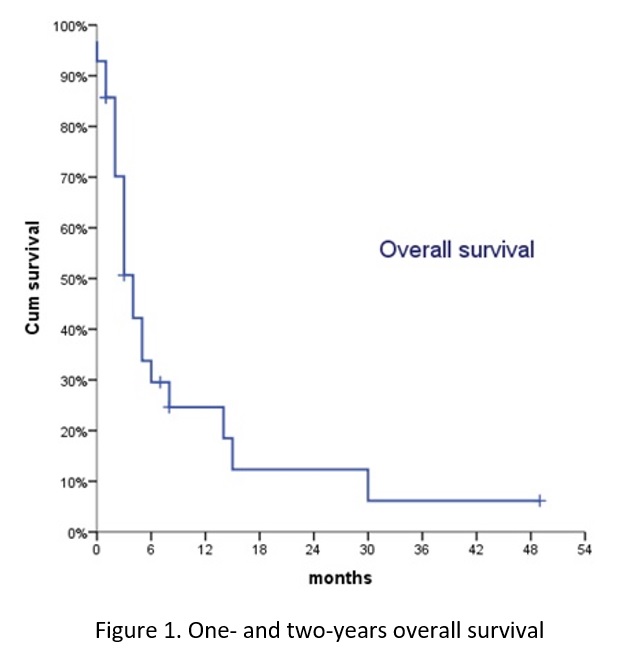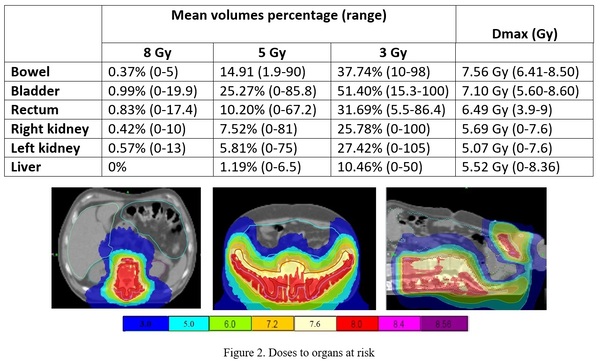Single fraction Lumbopelvic Bone Irradiation with Helical Tomotherapy for metastatic bone disease
PO-1449
Abstract
Single fraction Lumbopelvic Bone Irradiation with Helical Tomotherapy for metastatic bone disease
Authors: Beatriz Gil Haro1, Sofía Santana Jiménez1, Jesús Romero Fernández1, Rafael Molerón Mancebo2, Raquel Benlloch Rodríguez1, Marta López Valcárcel1, María Hernández Miguel1, Irma Zapata Paz1, Ruth Rodríguez Romero3, Lucía Paisán Palacio1, Alfonso Valcárcel Díaz1, Patricia Sarrión Rubio de la Torre1
1Puerta de Hierro University Hospital, Radiation Oncology, Madrid, Spain; 2Aberdeen Royal Infirmary NHS Grampian, Radiation Oncology, Aberdeen, United Kingdom; 3Puerta de Hierro University Hospital, Radiophysics, Madrid, Spain
Show Affiliations
Hide Affiliations
Purpose or Objective
To assess the
effectiveness and toxicity of single-fraction Lumbopelvic Bone Irradiation
(LPBI) with Helical Tomotherapy (HT) in patients with widespread painful bone
metastases.
Material and Methods
Between May-2010 and
Aug-2021, twenty-eight patients were treated with LPBI in our institution.
Clinical characteristics: 17 males, 11 females;
mean age: 65 yo (32-85). Most
frequent primary tumors were prostate (10) and lung (9) adenocarcinoma.
Radiation-therapy: PTV included all bones from the middle-third of the femur to
D9-L4 (depending on the extent of disease) plus 5 mm symmetrical margin. A
single-dose of 8 Gy was administered to all patients except 2 patients who had
received prior irradiation in whom 6.5 Gy was administered. Patients were
premedicated with 8 mg dexamethasone, 8 mg ondansetron and 500 cc
saline-solution. Subjective pain relief
and pain level (Visual Analog Scale–VAS) were evaluated.
Statistics:
Student’s-T-test.
Results
Median follow-up: 7
months (0-49). Pain relief: 26 patients. Mean VAS-score (at 3-weeks
postradiotherapy), decreased from 6.39 (4-9) to 2.54 (0-7) (p < 0.001). In
most of patients, the tolerance was mild (CTCAEv5.0-criteria). One patient
suffered a tumor-lysis-syndrome after radiotherapy that was resolved with
pharmacotherapy. None of 28 patients presented GU toxicity. Grade 1-2
toxicities were asthenia (8 patients), nausea (5 patients) and hematologic (10 patients).
Only one grade 3 lymphopenia was observed. One- and two-years OS were 24% and
12%, respectively (Figure 1).
Mean PTV: 3510cc
(1934-7178cc). Mean V95: 93.2% (80-100%). Mean D95: 7.4 Gy (6-8.2Gy). Mean
homogeneity index_RTOG: 1.08(1.01–1.15). Doses
to OAR are shown in Figure 2.


Conclusion
LPBI with HT is a
promising new high-conformal-technique very effective in the treatment of
widespread bone metastases with excellent tolerance rates.